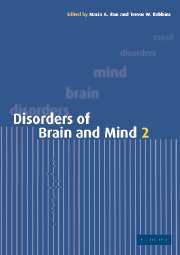Book contents
- Frontmatter
- Contents
- List of contributors
- Preface
- Part I Genes and behaviour
- Part II Brain development
- Part III New ways of imaging the brain
- Part VI Imaging the normal and abnormal mind
- Part V Consciousness and will
- 10 The scientific study of consciousness
- 11 Cognitive neurobiology of volition and agency in schizophrenia
- Part IV Recent advances in dementia
- Part VII Affective illness
- Part VIII Aggression
- Part IX Drug use and abuse
- Index
- Plate section
- References
11 - Cognitive neurobiology of volition and agency in schizophrenia
from Part V - Consciousness and will
Published online by Cambridge University Press: 19 January 2010
- Frontmatter
- Contents
- List of contributors
- Preface
- Part I Genes and behaviour
- Part II Brain development
- Part III New ways of imaging the brain
- Part VI Imaging the normal and abnormal mind
- Part V Consciousness and will
- 10 The scientific study of consciousness
- 11 Cognitive neurobiology of volition and agency in schizophrenia
- Part IV Recent advances in dementia
- Part VII Affective illness
- Part VIII Aggression
- Part IX Drug use and abuse
- Index
- Plate section
- References
Summary
Introduction
Since its initial description, schizophrenia has been known to affect volition: voluntary movement (Kraepelin 1919; Zec 1995; McKenna et al. 1998). But such abnormality is not restricted to the way that a movement is performed, it also affects its purpose. Patients may do things abnormally – they may also choose to do abnormal things. In this chapter we address the neural substrates of disordered action performance and the disturbed sense of agency that may occur in some patients with this disabling condition.
Volition and will
Volition encompasses a spectrum of voluntary behaviours and some of these (‘willed’, ‘intended’ or ‘freely chosen’) seem to us to be quintessentially human. The ‘will’ refers to our capacity to choose. We may ‘choose’ to ‘control’ some of our involuntary impulses. We may choose to attend to one stream of competing information over another. We may initiate conversations, many of which may be structurally unique and unpredictable. We may create a sequence for performing even the most mundane tasks. What we choose to do is an ‘action’; the one who chooses it is an ‘agent’ (Macmurray 1991). One influential theory characterized schizophrenia as a ‘disorder of action’ (Frith 1987). By making action central to schizophrenia, Frith's early theory made the latter a disorder of higher volition – of that which is willed (or chosen) over that which is automatic (Frith 1987; Liddle 1993; see Chapter 10 by Frith). Frith's theories have undergone changes and he currently uses ‘action’ to refer to all movements.
- Type
- Chapter
- Information
- Disorders of Brain and Mind , pp. 223 - 242Publisher: Cambridge University PressPrint publication year: 2003
References
- 1
- Cited by



